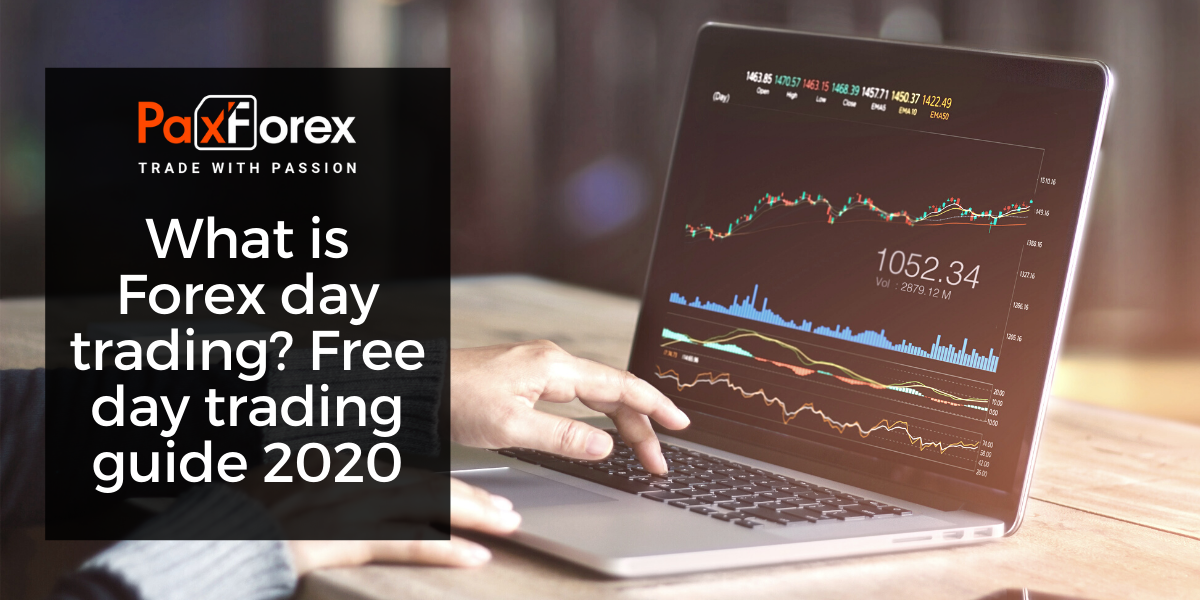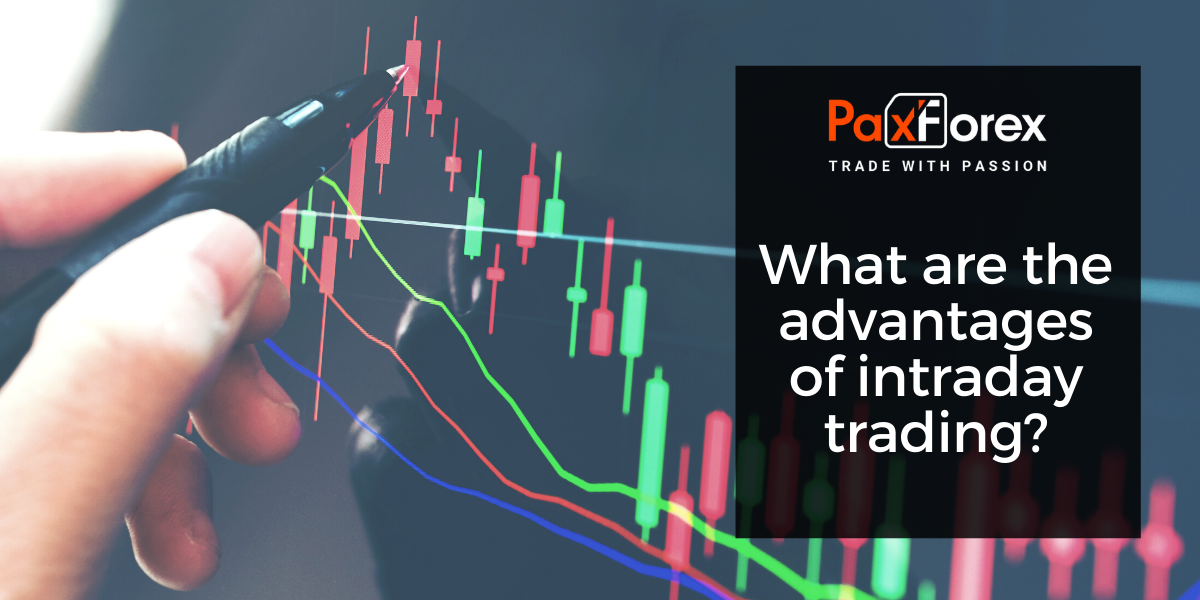
Day trading, as the name implies, means opening and closing positions within one trading day, without holding them till the next day. As a rule, this type of trading is popular among beginners, because they believe that the quantity will necessarily turn into quality, i.e., the more trades, the greater the profit made. It is also worth noting that it is novice traders most often go for violation of trading discipline and ignoring the trading plan because the pace of trade determines a quick decision making, which implies a certain experience. And the excitement and thirst for quick enrichment of a beginner have not yet had time to get rid of than he is attracted by intraday trading.
The range of timeframes used in intraday trading is wide - from M1 to H1, but beginners for some reason prefer timeframes M5 or M15, believing that by doing so they will be able to respond to every price change in time and get their profit. Often, due to the market noise typical for these timeframes, their positions are closed at a stop-loss, bringing losses.
This does not mean that intraday trading is unprofitable. On the contrary. Intraday trading can and will bring income, but only in case of unconditional observance of trading discipline, competent drawing up of a plan of action and rejection of all emotions.

There are two key advantages of intraday trading for a smart and demanding trader. They include:
- The absence of overnight risks.
When executing an intraday trading, the position is closed on the same trading day. What you sell or buy depends only on the market conditions at that time. You do not need to worry about nightly risks, such as a fall of the market in another hemisphere. They will not affect your profitability, as your trades are made when the market you are trading in is open.
- The potential for high returns
In a short period of time, equal to one trading day, you can accumulate huge profits. However, one of the decisive factors here is that you must have a smart strategy and adequate knowledge about securities and trends in order to open a proper trade.
What are the disadvantages of intraday trading?
- it is more difficult to determine the trend - as many analysts say, there is only one trend direction and it can be identified only in the long term. All other rate fluctuations are only rollbacks.
- a large amount of spread - concerning the received profit, you have to take into account the size of profit from one trade and the size of spread on this pair.
- inaccessibility of trading instruments - it is almost impossible to use currency pairs with a large spread in intraday trading, the trend movement during the day may not pay off the difference.
Before you start trading intraday, you must be aware of the risks associated with intraday trading and have a ready-made action plan in case you want to stop or exit the market at any time. Despite the promising profits, there are also significant risks and factors beyond your control that could lead to adverse results.
Some of you (or even all of you) are bothered by a single question - How much do forex traders make a day? First of all, we want to mention one important detail. Earnings should not be measured in money (dollars, euros, pounds, etc.), but in percent. Why? It is a more adequate assessment. Many beginners come to Forex, seeing an advertisement about "earning $100 a day, without doing anything", and they do not think that the initial deposit on the account can be 10, or maybe 1000 or even 10,000 dollars. And to earn $100 with a deposit of $50 or $1,000 is very different things.
Also sometimes some people may be wondering: if their strategy brings 200 points of profit per month - is it a lot or a not? It is neither. Because everything depends on the trading system. Some intraday traders catch 5 pips a day, while traders on the daily charts easily get a 100 pips profit/loss. Forex gives us the flexibility to choose the size of the position, and accordingly, you can earn 100 pips with 0.1 volume or 10 pips with 1.0. In monetary terms, the size of the profit will be the same.
What should be the profitability of a successful trader? But before, we can't help but mention the "100% per month" theme. Yes, you can get 100%. With the risk of losing the same 100%. And if we talk about stable, manual trading, intended for serious work, then with a yield of 2-5% per month, in successful months up to 10%, you can already consider yourself a professional. The main thing is that the profit gained is stable and without huge drawdowns.
In order to make day trading more effective, several rules will help the trader who has chosen this complex, but an interesting type of trading.
USE M30 AND H1 TIMEFRAMES FOR TRADING
When using Price Action patterns, you should not trade on timeframes lower than M30. The H1 timeframe and higher are best for this purpose. The point is that on small timeframes the very essence of reflecting market participants' actions with the help of Japanese candlesticks simply loses its meaning.
IT'S BETTER TO DO LESS, BUT BETTER.
Often, traders, especially beginners, give wishful thinking away, trying to find entry points where they simply do not exist. The trader changes the time frames, increases the price chart, redraws technical lines. In general, he tries in every possible way to adapt the current picture to his desire to open a position. This is an unprofitable way. If there is no clear signal for placing an order - you should not look for it. Switch to another currency pair or just wait for a clear signal to appear, otherwise, the risk of getting a loss at an unreasonable entry grows several times. In general, if there is no certainty - you should not enter the market.
There is a stable opinion that intraday trading implies opening a huge number of positions during the day. In fact, you can make a tangible profit by making only 1 or 2 transactions within a day.
2 CURRENCY PAIRS ARE ENOUGH FOR TRADING.
Intraday trading, as mentioned above, involves making clear trade decisions quickly. In pursuit of profit, a beginner opens 5, 10 or even more charts of currency pairs, thus only confusing himself. Only 2, maximum 3 currency pairs are enough for intraday profit.
The beginner will need only one currency pair. After the trade shows a stable positive result, you can proceed to trade on another one.
SMART MONEY MANAGEMENT
As in any other type of trading, compliance with the rules of money management is the key to success. You should not risk more than 1% of the deposit. Of course, you want to get more profit and faster, but after a series of loss-making trades, emotions can take over, which guarantees the loss of the entire deposit. By controlling the risk, the trader reduces the psychological burden and gets the opportunity to plan the losses.
And then how can one make a profit? To get profit, it`s necessary not to exceed the established risk level, but to enter the position accurately, correctly calculating the Take Profit level. Over time, it is possible to place several orders.
For beginner traders, it is necessary to achieve not mega-profits, but a stable income. Having received the necessary experience, the profit will also increase with the growth of skills.
DO NOT MISS THE NEWS
Any currency pair reacts to the release of economic announcements from the respective country. Especially on the lower timeframes, the price can easily trigger the Stop Loss and then turn in the right direction. Therefore, it is recommended not to open trades within 30 minutes before and after the release of an important economic indicator. So, a trader should not ignore the economic calendar under any circumstances.
PAT ATTENTION TO THE HIGHER TIME FRAMES
Do not limit yourself to just one time frame, as you can competently evaluate the dynamics of a currency pair only by analyzing several time frames. Therefore, when trading on H1, it will be helpful to analyze the charts H4 and D1.
For example, a sell pattern emerged on H1, while on H4 it will look like a correction within the uptrend. Can I Sell? It is possible. After all, you should not lose profit from the shorts, limiting yourself only by buying. However, you should be ready for the fact that the price may turn towards the trend at any moment.
CONTROLLING PROFITS AND LOSSES
Even though the Forex market is highly liquid, there are days when volatility is significantly reduced and it is impossible to squeeze at least a dozen points out of the market. Needless to say, no living man all things can. Set for yourself a clear volume of intraday profit and loss. For example, 50 points. Have you made a loss of 50 pips during the day? Do not try to get even, finish the trading day. You made a profit of 50 pips - the same. Do not try to pull out of the market "just a little bit more". Observance of trading discipline will help to control emotions and, in time, will become one of the factors of constantly profitable trading.
CURRENCY PAIR VOLATILITY WITHIN A DAY
For a trader, it would be quite useful to know the daily volatility of the currency pair he is going to trade on. For example, if the average daily volatility of a pair is 70 pips, it will be at least silly to wait for it to move 100 pips every time. In this case, it is better to fix most of the positions with a profit of 50 points and then move the Stop Loss to breakeven.
NO TIME LIKE THE PRESENT
You shouldn't leave open trades till the next day. If the session is coming to an end and the positions are still open, it is better to close them, as they say, "just in case", because with the opening of the next trading day the situation can change dramatically.
The abovementioned tips on intraday trading are just basic recommendations, not a hundred percent guide to action and do not fully reflect all the subtleties applied by Forex day trader. Of course, the most valuable tips and rules will be only those developed by the trader in practice. However, following the rules offered will reduce the risk of losses and increase the efficiency of day trading Forex.









